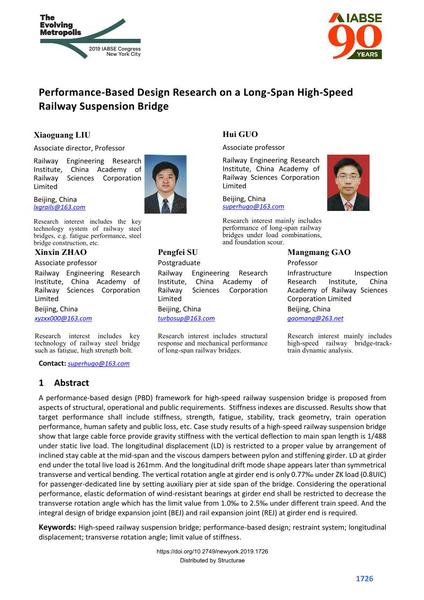Performance-Based Design Research on a Long-Span High-Speed Railway Suspension Bridge

|
|
|||||||||||
Bibliografische Angaben
| Autor(en): |
Xiaoguang Liu
(Railway Engineering Research Institute, China Academy of Railway Sciences Corporation Limited)
Hui Guo (Railway Engineering Research Institute, China Academy of Railway Sciences Corporation Limited) Xinxin Zhao (Railway Engineering Research Institute, China Academy of Railway Sciences Corporation Limited) Pengfei Su (Railway Engineering Research Institute, China Academy of Railway Sciences Corporation Limited) Mangmang Gao (Railway Engineering Research Institute, China Academy of Railway Sciences Corporation Limited) |
||||
|---|---|---|---|---|---|
| Medium: | Tagungsbeitrag | ||||
| Sprache(n): | Englisch | ||||
| Tagung: | IABSE Congress: The Evolving Metropolis, New York, NY, USA, 4-6 September 2019 | ||||
| Veröffentlicht in: | The Evolving Metropolis | ||||
|
|||||
| Seite(n): | 1726-1732 | ||||
| Anzahl der Seiten (im PDF): | 7 | ||||
| DOI: | 10.2749/newyork.2019.1726 | ||||
| Abstrakt: |
A performance-based design (PBD) framework for high-speed railway suspension bridge is proposed from aspects of structural, operational and public requirements. Stiffness indexes are discussed. Results show that target performance shall include stiffness, strength, fatigue, stability, track geometry, train operation performance, human safety and public loss, etc. Case study results of a high-speed railway suspension bridge show that large cable force provide gravity stiffness with the vertical deflection to main span length is 1/488 under static live load. The longitudinal displacement (LD) is restricted to a proper value by arrangement of inclined stay cable at the mid-span and the viscous dampers between pylon and stiffening girder. LD at girder end under the total live load is 261mm. And the longitudinal drift mode shape appears later than symmetrical transverse and vertical bending. The vertical rotation angle at girder end is only 0.77‰ under ZK load (0.8UIC) for passenger-dedicated line by setting auxiliary pier at side span of the bridge. Considering the operational performance, elastic deformation of wind-resistant bearings at girder end shall be restricted to decrease the transverse rotation angle which has the limit value from 1.0‰ to 2.5‰ under different train speed. And the integral design of bridge expansion joint (BEJ) and rail expansion joint (REJ) at girder end is required. |
||||


